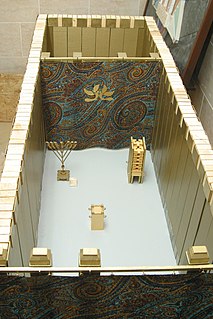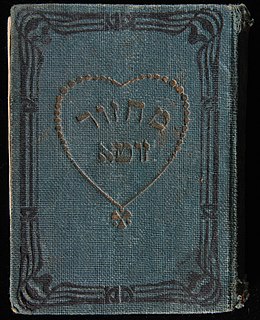 W
WYom Kippur, also known as the Day of Atonement, is the holiest day of the year in Judaism. Its central themes are atonement and repentance. Jews traditionally observe this holy day with a day-long fast and intensive prayer, often spending most of the day in synagogue services.
 W
WAcharei Mot is the 29th weekly Torah portion in the annual Jewish cycle of Torah reading. It is the sixth weekly portion in the Book of Leviticus, containing Leviticus 16:1–18:30. It is named after the fifth and sixth Hebrew words of the parashah, its first distinctive words.
 W
WAzazel In the Bible, the name Azazel appears in association with the scapegoat rite; the name represents a desolate place where a scapegoat bearing the sins of the Jews during Yom Kippur was sent. During the end of the Second Temple period, his association as a fallen angel responsible for introducing humans to forbidden knowledge emerged due to Hellenization, Christian narrative, and interpretation exemplified in the Book of Enoch, His role as a fallen angel partly remains in Christian and Islamic traditions.
 W
WThe Halle synagogue shooting occurred on 9 October 2019 in Halle, Saxony-Anhalt, Germany, and continued in nearby Landsberg. After unsuccessfully trying to enter the synagogue in Halle during the Jewish holiday of Yom Kippur, the attacker fatally shot two people nearby and later injured two others.
 W
WHarira is a traditional Moroccan soup. It is popular as a starter but is also eaten on its own as a light snack. There are many variations and it is mostly served during Ramadan, although it can be made throughout the year.
 W
WThe Holy of Holies or HaDvir is a term in the Hebrew Bible which refers to the inner sanctuary of the Tabernacle where God's presence appeared. According to Hebrew Tradition, the area was defined by four pillars which held up the veil of the covering, under which the Ark of the Covenant was held above the floor. The Ark according to Hebrew Scripture contained the Ten Commandments, which were given by God to Moses on Mount Sinai. King Solomon built the Temple in Jerusalem, where the Ark of the Covenant was supposed to be kept.
 W
WKapparot is a customary atonement ritual practiced by some Jews on the eve of Yom Kippur. This is a practice in which a chicken or money is waved over a person's head and the chicken is then slaughtered in accordance with halachic rules.
 W
WA kittel is a white linen or cotton robe worn by religious Jews on holidays, in the synagogue or at home when leading the Passover seder. Kittels are sometimes worn by grooms. It is also customary for Jews to be buried in a kittel.
 W
WThe machzor is the prayer book used by Jews on the High Holy Days of Rosh Hashanah and Yom Kippur. Many Jews also make use of specialized machzorim on the three pilgrimage festivals of Passover, Shavuot, and Sukkot. The machzor is a specialized form of the siddur, which is generally intended for use in weekday and Shabbat services.
 W
WIn the Bible, a scapegoat is one of two kid goats. As a pair, one goat was sacrificed and the living “scapegoat” was released into the wilderness, taking with it all sins and impurities. The concept first appears in Leviticus, in which a goat is designated to be cast into the desert to carry away the sins of the community.Then Aaron shall lay both his hands on the head of the live goat, and confess over it all the iniquities of the people of Israel, and all their transgressions, all their sins, putting them on the head of the goat, and sending it away into the wilderness by means of someone designated for the task. The goat shall bear on itself all their iniquities to a barren region; and the goat shall be set free in the wilderness.
 W
WSelichot or slichot are Jewish penitential poems and prayers, especially those said in the period leading up to the High Holidays, and on fast days. The Thirteen Attributes of Mercy are a central theme throughout these prayers.
 W
WYoma is the fifth tractate of Seder Moed of the Mishnah and of the Talmud. It is concerned mainly with the laws of the Jewish holiday Yom Kippur, on which Jews atone for their sins from the previous year. It consists of eight chapters and has a Gemara ("Completion") from both the Jerusalem Talmud and the Babylonian Talmud.